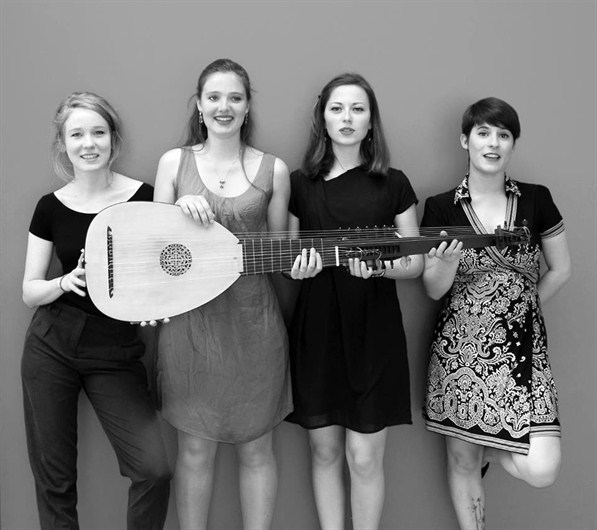Festival
Out of Place 2018: Les Kapsber'girls

Out of Place - Early Music(s) International Festival
LES KAPSBER’GIRLS
France / Switzerland
30.11.18 > 21:30
Pavilhão do Bodo, Salvaterra do Extremo
Alice Duport-Percier, soprano
Axelle Verner, mezzo-soprano
Barbara Hunninger, viola da gamba
Albane Imbs, archilute, baroque guitar, direction
Capacity 150 pax
Duration +-60’
Free entry subject to room capacity. For safety reasons, the door will be shut as soon as the room is full to capacity. Doors open +-30’ before the concerts start.
---
Vous avez dit Brunettes?
French popular songs of the 18th century: Airs de Cour and Brunettes... Have you said Brunettes?
This program focuses on French “popular” songs of the 18th century called Airs de Cour, or more specifically Brunettes. The songs appear for the first time in three volumes edited and arranged in 1703, 1704 and 1711 by Christophe Ballard (1641-1715), the Sun King’s official printer and editor of music. They totally represent a compilation of more than 516 airs.
Originally, the Brunettes were ancient popular melodies in oral tradition, most often monodies, performed a capella. Ballard added additional voices, basses and harmonization according to contemporary taste. They turned out to be an immediate and huge success in the middle and upper-middle-class and nobility. The Brunettes became equally a pedagogical repertory for teaching singing, exactly in the same manner that the actual pop songs are used today!
Christophe Ballard introduced his first volume with the song “Le beau Berger Tircis” thus giving to the “Brunettes” their name taken from a chorus “Ah ! Petite Brunete, Ah! Tu me fais mourir !”. Christopher’s son, Jean Baptiste successes his father editing several other songbooks of Brunettes and Airs de cours.
We may compare these light songs and their incredible popularity to contemporary pop music. They were extremely famous and fashionable, and except the fact that mythological figures are no more the heroes of modern pop songs, love still remains one of the main subject. Our choice of music, taken from a large vocal baroque repertory reflecting our formation, was motivated by the freshness that the Brunettes still generate for modern ears. In addition, we always strive to find and re-appropriate ourselves forgotten repertory such as the Brunettes unfairly neglected until now.
One of our previous programs focused on Villanelles of Kapsberger (1580-1651), which maybe considered the exact counterpart of the Brunettes, arising a century earlier in Italy.
Another gender of airs enclosed in this program are the Airs à Boire, - humoristic and parodic songs reflecting a genuine enthusiasm for the pleasures of the table and…the wine.
Our choice of instrumentation was conducted by their common use and popularity in the very beginning of 18th century. One of the most appreciated instruments in the French baroque music was undoubtedly the viola da gamba for which many composers dedicated their works. Among the most famous violist : Jean de Sainte-Colombe who, together with his pupil Marin Marais, developed, the most accomplished style and playing techniques for the instrument. In the same instrumental family, appears the par-dessus de viole, a soprano range instrument, tuned an octave and a forth higher than the bass viola, competing with the much-appreciated violin. The specialist of this instrument was the nowadays forgotten Nicolas Lendormy. His compositions, as unknown as appreciable. As far as the plucked instrument is concerned, we have a preference for the archlute which permits, thanks to his large tessiture (five octaves!), to accommodate sopranos voices offering gracious melodic lines, as well as supplying harmonization and low basses for the viola.
The baroque guitar was highly appreciated at the Royal court and was directly imported from Italy, inspiring composers such as Robert de Visée, most well-known for his theorbo compositions. The suite in D minor performed in this program is arranged as a typical dance suite : prelude – allemande – courante – sarabande – gigue – gavotte – bourée – menuet – passacaille – menuet. The third plucked-instrument present in the concert is the tiorbino. Suffering as much disrespect as the pardessus de viole, the tiorbino is literally a miniature theorbo tuned an octave higher than its respective cousin. With the re-entrant tuning and extended range, it provides very special colors to the Basso Continuo part, as in Les Rossignols of Elisabeth Jacquet de la Guerre, imitating the songs of the birds.
A strong characteristic of the French Baroque music, is undoubtedly the use of ornamentations and embellishments as well in vocal as instrumental music. A large part of the ornamentation is marked in the scores by using specific signs but each individual musician, according to his gift of fantasy and eloquence, is supposed to add his proper inventions.
We like to think that the magic in this music lay in its secular character modernized by a well-off society enjoying the pleasures and artistic emulation of the Golden Age of Versailles.
Albane Imbs
+info: Fora do Lugar 2018